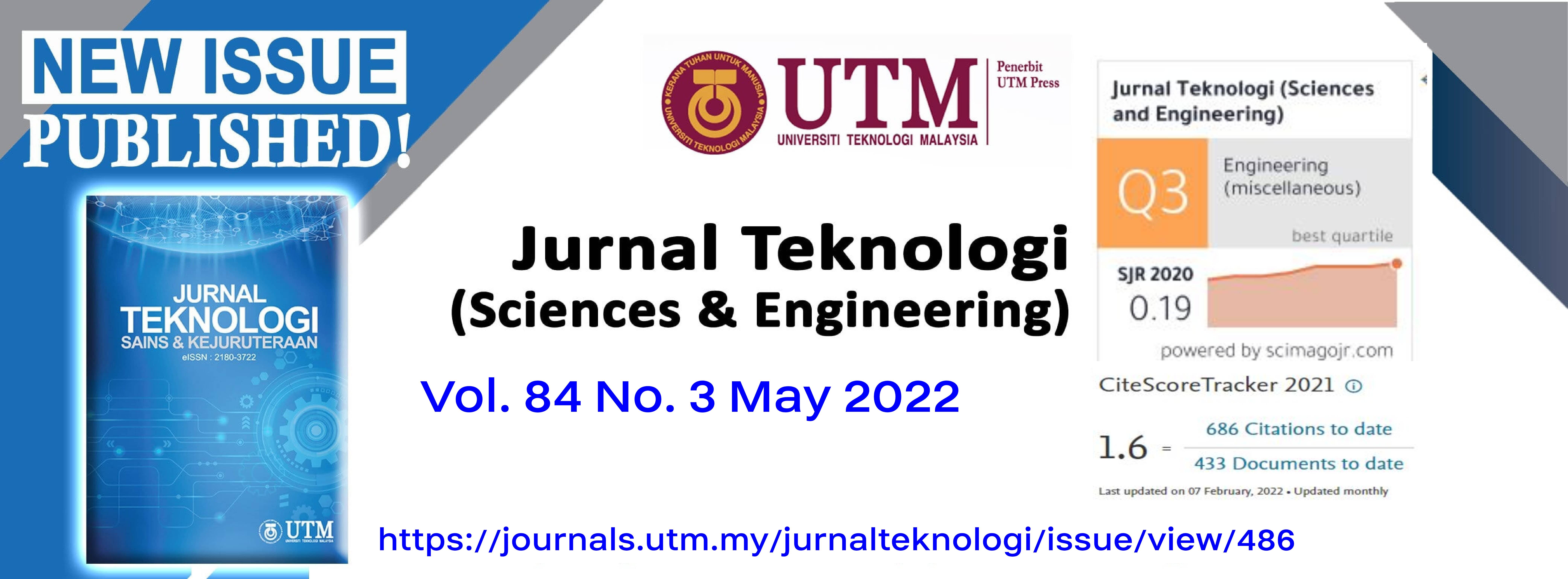APPLICATION OF ANALYTIC HIERARCHY PROCESS TO DETERMINE AND OPTIMIZE FDM PRINTING PROCESS PARAMETERS FOR TENSILE STRENGTH
DOI:
https://doi.org/10.11113/jurnalteknologi.v84.17802Keywords:
AHP, FDM, PLA, Tensile strength, Process ParametersAbstract
This paper investigates the application of the analytic hierarchy process (AHP) to optimize Fused Deposition Modeling (FDM) printing process parameters to obtain the best tensile strength from several test specimens. To proceed with applying the AHP, the data to list the most effective process parameters that affect the tensile strength was collected from various journals. After obtaining the best option from the AHP analysis, a tensile strength test was conducted to validate the data. Standard ASTM specimen with a gauge length of 57 mm and a gauge width of 13mm and the material specimen of Polylactic Acid (PLA) was printed using an open-source FDM printer. The result shows that from the AHP, option 3 has the highest score of 0.7723, and the best process parameter for tensile strength of the FDM process is layer thickness of 0.3mm, infill density of 80%, build orientation of 00, and raster angle of 600. Finally, to validate the result from the AHP, the tensile strength test of option 3 was done, and it shows that option 3 has the highest tensile strength, which is 2556 N/m2 compared to the other two options. This study is significant because it shows that AHP is feasible to obtain the optimum proses parameters that influence the mechanical properties of the printed test specimens.
References
V. G. S and P. V Gharat. 2016. 3D Printing Process Using Fused Deposition Modeling. International. Research Journal of Engineering Technology. 3(3): 1403-1406.
M. Attaran. 2017. The Rise of 3D Printing: The Advantages of Additive Manufacturing Over Traditional Manufacturing. Bus. Horiz. 60(5): 677-688.
M. Gayette. 2019. 5 Major Benefits of Additive Manufacturing You Should Consider. https://www.cmtc.com/blog/benefits-of-additive-manufacturing (accessed Oct. 27, 2020).
D. B. Patel. 2016. Additive Manufacturing – Process, Applications and Challenges. 2(5): 883-889.
W. Stephen. 2015. Additive Manufacturing as an Enabling Technology for Green Hybrid Spacecraft Propulsion. 7th International Conference on Recent Advances in Space Technologies (RAST), IEEE. 1-6.
T. A. Pachemska, M. Lapevski, and R. Timovski. 2014. Analytical Hierarchical Process (AHP) Method Application in the Process of Selection and Evaluation. Proceedings. Gabrovo Internatinal Sci. Conference. 21-22 November 2014. 373-380.
I. Peko, N. Gjeldum, and B. Bilić. 2018. Application of AHP, Fuzzy AHP and Promethee Method in Solving Additive Manufacturing Process Selection Problem. Tehnički vjesnik. 25(2): 453-461.
H. Taherdoost. 2018. Decision Making Using the Analytic Hierarchy Process (AHP); A Step by Step Approach. International Journal of Economic. Management System. (January 2017): 244-246.
A. T. Ibraheem and N. S. Atia. 2017. Applying Decision Making with Analytic Hierarchy Process (AHP) for Maintenance Strategy Selection of Flexible Pavement. Global Journal of Research. 16(5).
Brunelli, M. 2014. Introduction to the Analytic Hierarchy Process. Springer.
S. Bardiya, J. Jerald, and V. Satheeshkumar. 2020. The Impact of Process Parameters on the Tensile Strength, Flexural Strength and the Manufacturing Time of Fused Filament Fabricated (FFF) Parts. Mater. Today Proc. 39: 1362-1366.
M. Hikmat, S. Rostam, and Y. M. Ahmed. 2021. Investigation of Tensile Property-based Taguchi Method of PLA Parts Fabricated by FDM 3D Printing Technology. Results Eng. 100264.
A. Rodríguez-Panes, J. Claver, and A. M. Camacho. 2018. The Influence of Manufacturing Parameters on the Mechanical Behavior of PLA and ABS Pieces Manufactured by FDM: A Comparative Analysis. Materials (Basel).11( 8).
Downloads
Published
Issue
Section
License
Copyright of articles that appear in Jurnal Teknologi belongs exclusively to Penerbit Universiti Teknologi Malaysia (Penerbit UTM Press). This copyright covers the rights to reproduce the article, including reprints, electronic reproductions, or any other reproductions of similar nature.
















